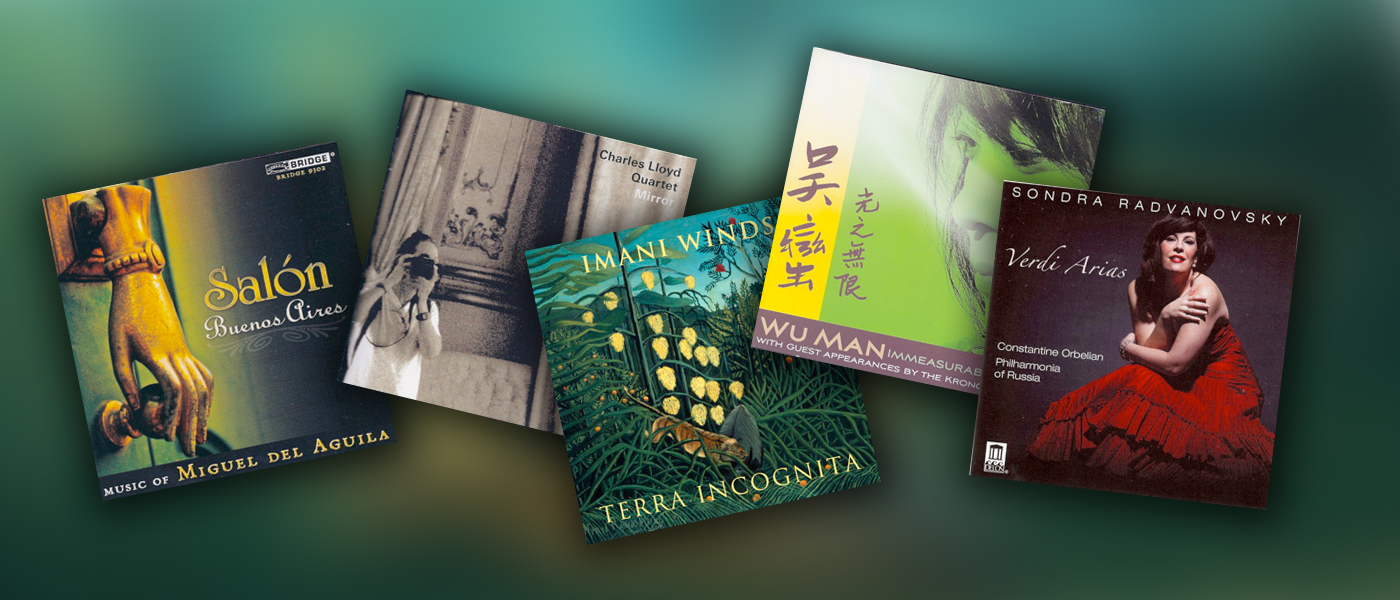Sales of high definition (high resolution or “high rez”) music on discs have floundered, and producers are in a difficult bind because it is expensive to master them, and with profits on high rez albums thus being low, they are looking for a different outlet. Well, downloading high rez music is the answer. The music studios, as well as independent musicians, can simply transfer the original high resolution masters (usually 24/88.2 or 24/96) to websites that specialize in selling music by download. The high rez disc does not have to be created, packaged, or distributed by the studio. It costs them nothing to put the music on a website store. The consumer downloads the music and burns it to a disc or plays it from a computer. The reviews here are of high resolution albums that were downloaded and burned to DVD-A using a software program (the procedure is described here). I listened to them with an OPPO BDP-83/NuForce universal player, Lamm LL1 preamplifier, McIntosh MC1201 power amplifiers, and Carver Mark IV ribbon speakers.
I obtained all of these albums courtesy of HDtracks on-line. Some albums are remastered from the original recordings made in the 1970’s on analog tape and converted to SACD two-channel and multi-channel surround sound. The audio files at the HDtracks website are two-channel PCM versions.
![]()
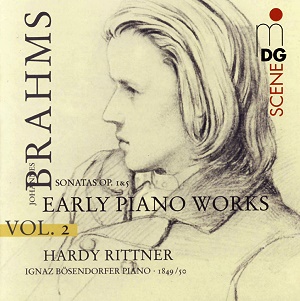
Johannes Brahms (1833 – 1897) was German and composed during the Romantic Period. His importance in music history is reflected by the fact that he is considered to be one of the Three B’s (Beethoven, J.S. Bach, and Brahms). A master of counterpoint, like Bach, his music was influenced by those in the Baroque and Classical Periods. His work was an inspiration for many who followed him, including Arnold Schoenberg. His largest choral work was A German Requiem (1868). He also wrote four symphonies and two concertos. The album reviewed here contains piano sonatas composed in his youth.
This recording obviously was made in a large hall, judging from the reverberation. The piano microphones were not placed well, delivering a narrow soundstage of the instrument. However, the recording, in general, has excellent dynamics, with track 2 sounding like a funeral and tracks 3 and 4 testing the ivories’ ability to withstand a pounding.
Johannes Brahms – Early Piano Works, Vol. 2 – Hardy Rittner – MDG Records – 2008 – 24 Bit/88.2 kHz – Category: Classical
- Performance:

- Sonics:

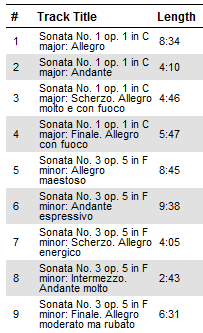
![]()
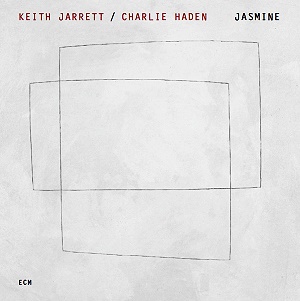
Keith Jarrett (b. 1945) is a jazz pianist who has played with the likes of Art Blakey (drums) and Miles Davis (trumpet). He is a graduate of Berklee College of Music and is lucky enough to posess absolute pitch. He was hired by Blakey in the 1960’s, but also headed up his own groups during that decade. In the 1970’s he played in trios, but also as a soloist. Although he frequently makes vocal sounds while playing, he does not tolerate noise from the audience, such as coughing. He would complain about the piano and curse photographers. But in spite of a difficult personality (it reminds me of Buddy Rich), his music speaks for itself.
Jarrett’s only accompanyist on this album is bassist Charlie Haden, and some of the tracks cry out for a rhythm section (drums), like track 3. This album would be wonderful dinner music in the background. The melodies are obvious, easy to follow, with none of the discord that is prevalent in so much of modern jazz. Great music for dancing in the dark too.
Keith Jarrett/Charlie Haden – Jasmine – ECM Records – 2010 – 24 Bit/44.1 kHz – Category: Jazz
- Performance:

- Sonics:


![]()
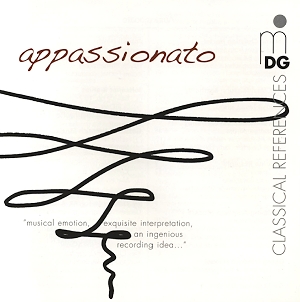
Compilations of music in a particular category by various composers are very popular. They work great as background music for dinner parties because each track is quite different than the last one. The all star lineup here includes Mozart, Brahms, Schubert, Liszt, and Tchaikovsky.
The first track on this recording is a good one to test how tight your woofer drivers are, as the tympanis pound away the introduction. There is a wide variety of music, and I particularly enjoyed track 2’s exceptional melody. There are also some very intense tracks, such as track 14, which are not very relaxing, so I wouldn’t suggest this album as background music for reading the newspaper.
Appassionato – Various Artists – MDG Records – 2008 – 24 Bit/88.2 kHz – Category: Classical
- Performance:

- Sonics:

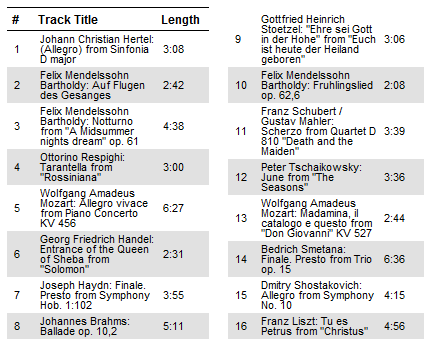
![]()
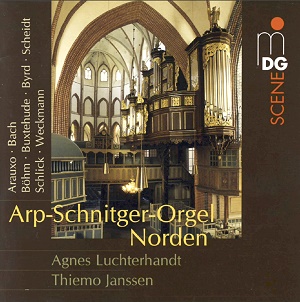
Unlike the album above, which would work nicely at a dinner party, this album focuses on classical pipe organ, not the kind of thing you would want to be playing while chomping on a filet with a glass of chardonnay. Arp-Schnitger is the name of the organ builder, located in the town of Norden, which is in northern Germany. It radiates in three directions, so if you like surround sound, perhaps a trip to Germany is in order to hear it from the source. J.S. Bach himself played this organ, so it has been around for awhile.
The recording has a wonderful soundstage, and it is not easy to record an instrument where the sound producing components are spread out over a large distance. The various tracks utilize many of the organ’s stops so you get a good idea of what the instrument is capable of. Organ music is not for everyone, but this recording is a good one if you like the genre.
Arp-Schnitger-Orgel Norden – Agnes Luchterhandt, Thiemo Janssen – MDG Records – 2005 – 24 Bit/88.2 kHz – Category: Classical
- Performance:

- Sonics:

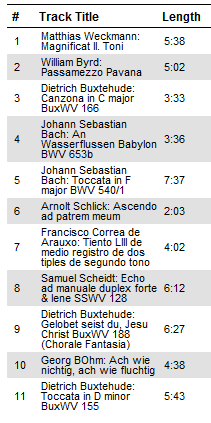
![]()

Fr̩d̩ric Chopin (1810 Р1849) was born in Warsaw, Poland, and was a piano virtuoso of the Romantic Period. The majority of his compositions are for solo piano. His romantic activities included a relationship with Amantine Aurore Lucie Dupin, baronne Dudevant, better known by her pseudonym, George Sand, a French novelist. Again, a genius who died in his youth, in this case, of tuberculosis.
I was a bit surprised at the rather narrow soundstage in this recording, and some of the microphones seem to be at different distances from the various instruments, which throws the overall sound towards being a bit unbalanced. Of course, the piano is front and center. Ms. Kodama is very adept at her instrument, although the microphone placement didn’t allow for much stereo depth. Nevertheless, it is a beautiful recording that exemplifies Chopin.
The first graph shown below is a spectrum from the first movement (track 1). Notice that the response drops off sharply above 22 kHz. The recordings supplied to HDTracks may have been simply upsampled from the CD version (something that has been discovered recently to be the case for a number of “SACD” albums). The second spectrum is from the stereo version on the original SACD, and it shows a response out to 30 kHz, along with the usual noise hump that is characteristic of SACD recordings. Note that this is not a problem caused by HDTracks. They simply use whatever stereo master recording the studios send and convert them to 24/88 or 24/96 FLAC files for downloading by consumers. This album is a PentaTone Classic, and I plan to keep an eye on other albums from this label. In any case, if you like this particular album, purchase the original SACD.
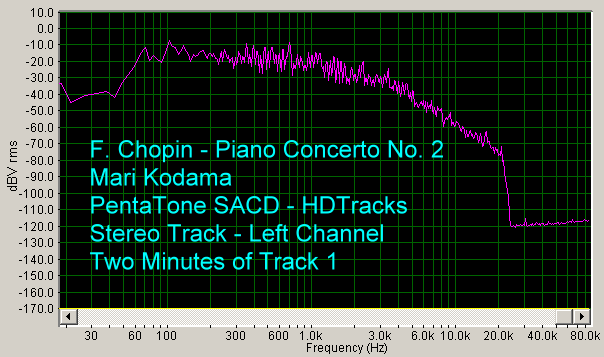
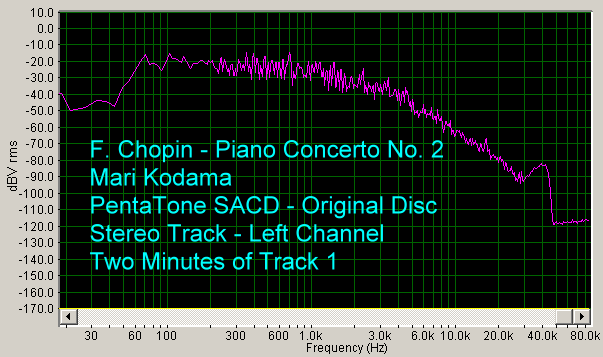
Frederic Chopin – Piano Concerto No. 2 – Mari Kodama, Russian National Orchestra, Kent Nagano – PentaTone Classics – 2003 – 24 Bit/88.2 kHz – Category: Classical
- Performance:

- Sonics:


![]()


